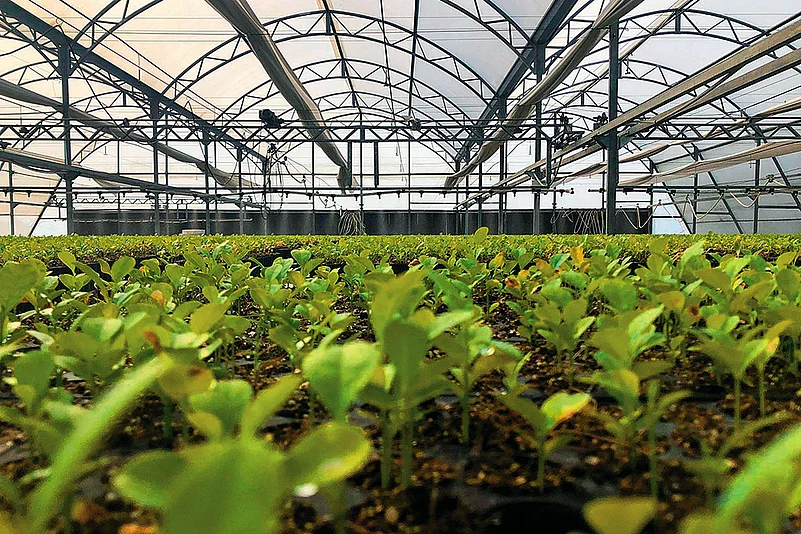When finance minister Nirmala Sitharaman announced the setting up of a fund with blended capital to be facilitated through the National Bank for Agriculture and Rural Development (NABARD) in her Budget speech, she indicated the government’s serious inclination towards agritech.
The segment, which, according to a Bain & Company report titled Indian Agriculture: Ripe for Disruption, will be worth $30-$35 billion by 2025, is indeed buzzing. In fact, global collaborations and cross-border ventures are redefining the sector. In the ongoing Expo Dubai, several Indian agritech companies are pitching to global players—while TraceX Technologies’ Brighu Ravi Bhattrahalli is trying to promote his blockchain-powered digital platform to connect players in the food and agri supply chains across geographies, Ramarao Peddi of Greentatwa Agri Tech is pitching his sustainable integrator for the promotion of chemical-free food products. More than 500 start-ups from India are at the expo showcasing their innovations.
Foreign Forays
There are already a few successful examples of foreign forays in the form of AgNext, CropIn Technology Solutions and Intello Labs. CropIn, a geo and crop-agnostic deep-tech intelligence platform, claims to receive 80% of its new revenue bookings from international markets. The company works with over 250 organisations in 56 countries across the globe. “We are digitising over 16 million acres of farmland and building intelligence for more than 400 crops and over 10,000 crop varieties, thereby impacting the lives of nearly seven million farmers globally,” says Krishna Kumar, founder and CEO, CropIn.
Experts believe it is only a matter of time before the trickle of Indian agritech turns into a torrent abroad. “There is a lot of potential in Africa, China and Southeast Asia with their small landholder farmers,” says Hemendra Mathur, chairman of the FICCI task force on agri start-ups, and venture partner, Bharat Innovation Fund.
Organisations such as the NITI Aayog, Bill & Melinda Gates Foundation and Rabo Foundation have also been promoting cross-border agritech collaborations between India and countries like Indonesia, Malawi, Malaysia, Kenya, Uganda, Zambia. The African-Asian Rural Development Organization, too, has been engaged in creating an ecosystem for cross-border technology transfer and businesses.
India Calling
Foreign start-ups, too, like their Indian counterparts, are trying to find a stronghold in India. The trend is cross-border. International agritech companies like Indigo Ag from the US, Plantix Agritech from Germany and Pessl Instruments from Austria have entered India. Netafim from Israel has been around for a while.
“Our app uses artificial intelligence to offer diagnosis with 92-95% accuracy for problems which experts may even fail to detect,” says Sawan Patidar, vice president, marketing, Plantix Agritech India. The mobile app for crop advisory for farmers claims to diagnose about 600 crop diseases from photos uploaded by farmers and offers treatment in 18 languages to more than 20 million users.
Israel’s Biofeed offers a solution that reduces fruit fly infestation by 99.9% without using chemical sprays. Indian fruit growers suffer a 30-80% crop yield loss due to the overuse of pesticides. Biofeed poses as an answer to their losses with its solutions.
The Agency for International Development Cooperation in the Ministry of Foreign Affairs of Israel is also at work to promote the use of Israeli technology in agriculture in India. Israel is planning to create villages of excellence and 13 centres of excellence to promote advanced agricultural technologies across the country. “These centres are increasing Indian farmers’ yield, productivity and quality while diversifying local crops,” says Yair Eshel, agriculture attache, Embassy of Israel.
Soaring Investments
The increasing investments in agritech bear the testimony of its bright future. Agritech start-ups raised $700 million-$1 billion in 2021, according to industry estimates. “The pandemic has catalysed the growth in agriculture because it was largely the only performing sector. The fact that it is unorganised also helped,” says Vijay Pratap Singh Aditya, who co-founded Ekgaon, a network integrator which uses mobile phone apps to transmit verified information across the farm value chain, helping enhance farm productivity and saving cost.
The agritech market is projected to become worth $30-$35 billion by 2025 with opportunities for establishing integrated agritech platforms, incubation hubs for developing new business models and transforming old business models, according to the Bain & Company report.
Bain & Company is not alone in projecting high growth for the sector. The deployment of technology to overcome challenges in the conventional value chain offers a market potential of $24 billion by 2025, found a 2020 EY report titled Agritech: Towards Transforming Indian Agriculture. The segment can be broken down into supply chain technology and output market linkages ($12.0 billion), financial services ($4.1 billion), precision agriculture and farm management (3.4 billion), quality management and traceability ($3.0 billion) and market linkages-farm inputs ($1.5 billion).
Budget Impetus
“The exciting announcement about NABARD, which is already very active, launching a fund of funds to support start-ups is very encouraging. It will have a positive impact on the whole ecosystem,” says Mark Kahn, managing partner at venture capital firm Omnivore. Besides, this year’s budget has also committed to promoting Kisan drones for crop assessment, digitisation of land records and spraying insecticides and nutrients. The government’s focus on creating an enabling ecosystem for the promotion of digital technology has sent an important signal to the industry.
It is a shot in the arm for companies like Marut Drones and IG Drones. The former offers services like unmanned aerial vehicle-based hyper-spectral and multi-spectral imaging, data analytics and machine learning to aid crop diagnostics and targeted spraying. IG Drones carries out activities like plant counting, irrigation monitoring and planning, crop damage assessment and pesticide spraying.
This year’s budget has given a catalytic push to agritech. “It is a very clear and positive message that you are part of the India growth story. All the players in the agritech ecosystem are more confident now that the government is also aligning its effort to strengthen an enabling ecosystem,” says Ashok Varma, partner, PwC India.
Value Proposition
Agritech is enhancing productivity by facilitating real-time linkage between input providers, digital marketplace and physical infrastructure, and access to credit facilities for input procurement and equipment. “We offer 360-degree solutions related to advisory, sowing, growing, harvesting and forward linkages,” says Arvind Godara, co-founder, AgriBolo, a marketplace which offers seeds, fertilizers and pesticides with home delivery. It offers farm equipment, like the tractor, on pay-per-use basis.
Hedging against nature-linked risks is provided by using weather and geo-spatial data as also internet of things (IoT) to track and provide ecosystem information about weather, humidity and soil conditions. Promoting insurance of crops also follows the availability of weather-related data.
Besides, increasing the use of technology is helping reduce wastage and is enabling farmers to pursue sustainable agricultural practices. “We use IoT to generate and provide actionable information at the farm level on select crops across multiple geographies. Our devices are affordable and user-friendly,” says Shailendra Tiwari, founder, Fasal. The company claims an increase in yield of up to 40%,reduction in water usage of up to 50% and pesticide usage of up to 60%.
“World Wide Fund for Nature–India, too, has had a similar experience about water savings,” adds Murli Dhar, director of the sustainable agriculture programme at the WWF-India, which works with cotton growers in Jalna, Maharashtra. The farmers are provided information through a technology and data science-enabled decision support system called Cotton Doctor.
Future of Agritech
“A number of trends are supporting the agritech growth story, but to accelerate the growth rate at scale, it is necessary to ensure that the benefits accrue to all stakeholders. For example, the value proposition of income enhancement should be clear to the farmer,” says S. Sivakumar, group head of agri and IT business at ITC Limited.
However most of the agritech initiatives being point solutions may not translate to more money for farmers. Information needs to be followed up with advisory. It can lead to action if input supplies are available. It, in turn, calls for access to finances, which should be covered by insurance. Point solutions need to be integrated by platforms, he says.
The government needs to set standards to enable interoperability between collaborators and digitise land record data and make it available. Such initiatives can be anchored best by the government, adds Sivakumar of ITC Limited.
Omnivore’s Kahn, too, says that there is a huge challenge and opportunity around the issue of digital land records which are practically non-existent.
This will go a long way in facilitating what the public and the private sectors are trying to do ensuring that subsidies go to right beneficiaries and accelerating the growth of the agritech ecosystem. It can also enable farmers to control and monetise their data.


























